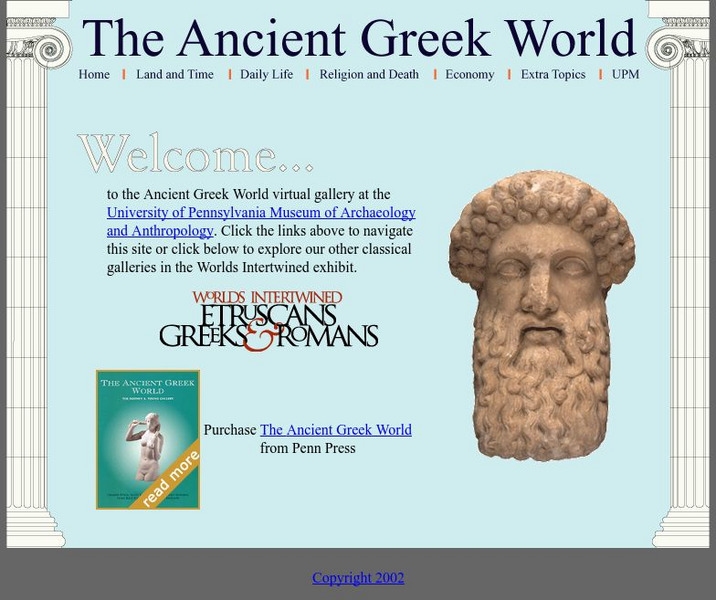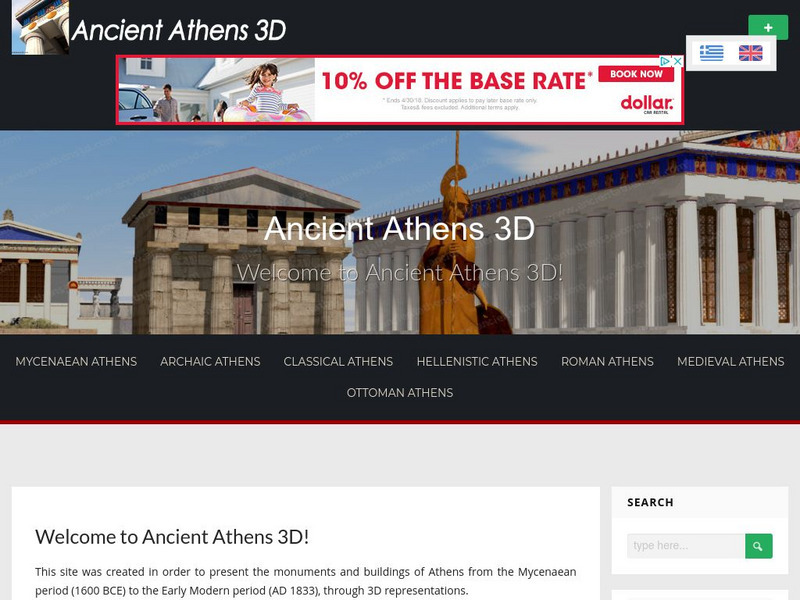ArtLex
Art Lex: Hellenistic Art Period
Artlex.com defines and describes the Hellenistic period in Western art. Features include links to illustrated examples, artists, and related terms.
Metropolitan Museum of Art
Metropolitan Museum of Art: Art of the Hellenistic Age and the Hellenistic Tradition
The Metropolitan Museum of Art offers a slideshow presentation of Hellenistic art.
Steven Kreis, PhD
The History Guide: From Polis to Cosmopolis
A great overview of the world of Alexander the Great, beginning with the military exploits of his father, Philip of Macedon. Included is a look at Hellenistic philosophies.
Penn Museum
Penn Museum: Ancient Greek World
Explore all aspects of life in ancient Greece. From the Mycenaean to the Hellenistic time periods, learn about Greek daily life, roles for men and women, religion and religious ceremonies, and the Greek economy.
Other
Ancient greece.org: History of Greece: Periods Overview
A timeline of the ancient periods of Greek history.
Penn Museum
Penn Museum: Ancient Greek World
Massive site for information on the ancient Greek world. Follow the navigation at the top of the page for detailed sections on time periods, daily life, religion and death, economy, and more. Each section includes pictures of artifacts...
Other
Foundation of the Hellenic World: Hellenic History
A site devoted to presenting the history of Greece all the way back to the Stone Age. Choose which period you want to know more about, then choose English for a translation.
Other
Ancient Athens 3 D
This website is devoted to documenting the buildings and monuments of Athens from the Mycenaean Period to about 1800 AD. Choose an era and read about the history and structures of that time period. The last section is a complete list of...
Khan Academy
Khan Academy: Development of the Buddha Image
There is significant debate concerning the development of the Buddha image--where it first occurred, why, and when. Broadly speaking, the image of the Buddha emerged during the first few centuries C.E. in two major centers of Indian art...
Tom Richey
Tom Richey: Power Point: Alexander the Great
PowerPoint presentation includes 50 slides with pictures, maps and information for students to learn about Alexander the Great's life and conquest.
Other
Focus Multi Media: History of Egypt
This site from FOCUS MultiMedia contains a concise history of Egypt from the time of the pharoahs through the Hellenistic Period. An interesting site to check out on the subject, and it contains a picture as well as a time line.
Curated OER
Unesco: Bulgaria: Thracian Tomb of Kazanlak
Discovered in 1944, this tomb dates from the Hellenistic period, around the end of the 4th century BC. It is located near Seutopolis, the capital city of the Thracian king Seutes III, and is part of a large Thracian necropolis. The...
Curated OER
Educational Technology Clearinghouse: Maps Etc: Plan of Olympia, 776 445 Bc
A plan of the ancient Greek sanctuary of Olympia, the site of the Olympic Games. Olympia is near the Peloponnese city of Elis. The plan shows the location of the stadium, gymnasium, temple, and other ancient features, including buildings...
Curated OER
Educational Technology Clearinghouse: Maps Etc: Hellas and Peloponnesus, 300 Bc
Map of Hellas and Peloponnesus in 300 BC, during the Hellenistic Period after the death of Alexander the Great.
Curated OER
Eternal Egypt: Hadara Container
A Hadara container dates from the Hellenistic period. It has a broad rim and a pear-shaped body. It is adorned with drawings of fish and flowers. The concave base is decorated with long harmonious lines colored white and orange.
Curated OER
Eternal Egypt: Jug of Lagynos Style
A pottery lagynos, which is considered to be one of the containers that were sealed, such as jars, amphorae and oinochoi, which were used to preserve liquids and were all related to table service all through the Hellenistic period.
Curated OER
Eternal Egypt: Black Granite Statue of a Priest
A black granite statue of a priest with a shaven head that dates back to the Hellenistic period. The priest is carrying a canopic jar; his left cheek is resting against the jar. He is wearing a gown that covers his whole body and his hands.
Curated OER
Eternal Egypt: Pestle of Massive Stone
A cylindrical device made of massive stone, which dates back to the Hellenistic period. This pestle has rounded edges and was used with a mortar to grind corn or other hard food. Wheat and corn were ground in this way to make flour.
Curated OER
Eternal Egypt: Jar for Holding Liquids
A small jar that has a high cylindrical neck and a moderately high round body. It was part of the table service and was used to serve liquids. Such jars were commonly used all through the Hellenistic period.
Curated OER
Eternal Egypt: Oil Lamps for Illumination
Four oil lamps from the Hellenistic period were found during excavations at the location of the Alexandria Library.
Curated OER
Eternal Egypt: Marble Head of a Philosopher
A marble head depicts a man, with short hair, a long beard, and a moustache. The form of the statue indicates that he is a philosopher from Alexandria, for the city was full of intellectuals and philosophers in the Hellenistic period.
Curated OER
Eternal Egypt: Royal Head Made of Pink Granite
A carved royal head made of pink granite; it is dated to the Hellenistic period. The head is covered by a Nemes headdress, a small part of the nose is broken. This is one of the objects found among the sunken antiquities of Alexandria.
Sophia Learning
Sophia: Historical Influences on Morality: A Basis for Literary Study
Using this PDF lesson plan, students will get a general overview of the historical span of philosophical thought and how it may have been a product or reaction to the time period. Students will research philosophies and time periods...










